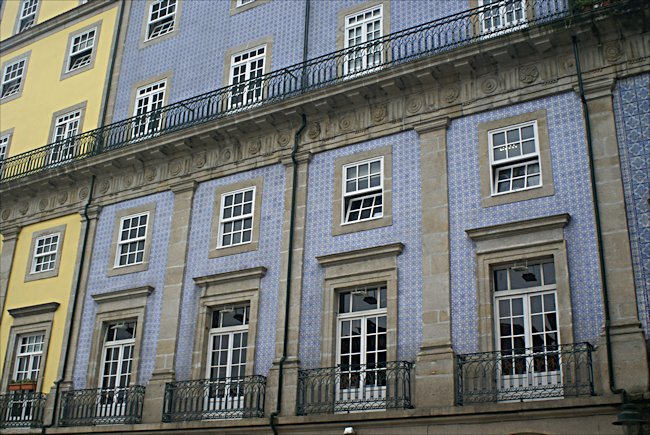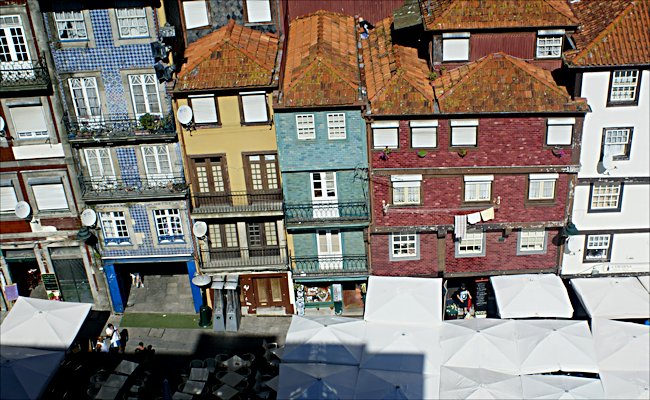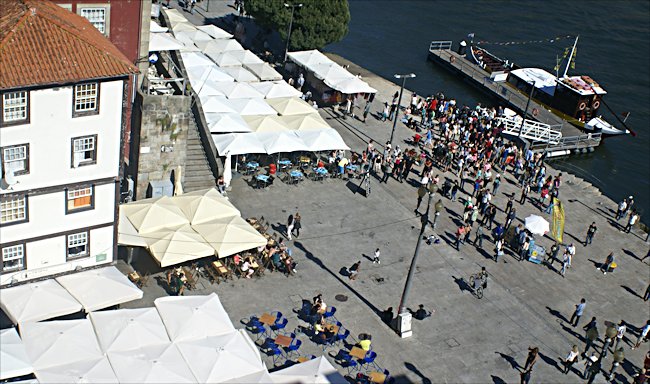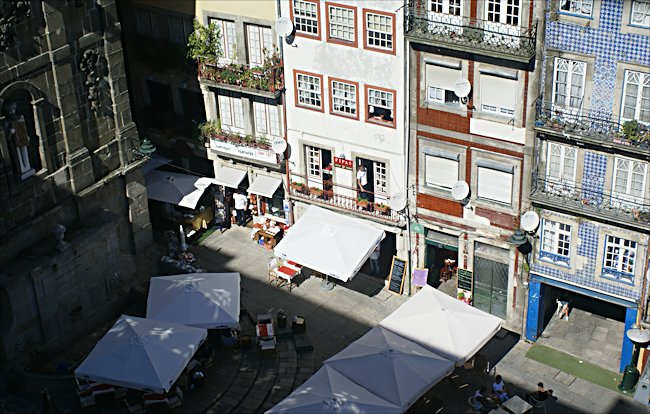Porto's Ribeira Square
The Ribeira area of Porto is very popular with tourists. It's charming, iconic and has wonderful views of the river Douro valley and the famous giant, industrial revolution, wrought iron bridges.

This is the elegant decorated building hotel frontages on the west side of Praca Da Ribeira Square
The Portuguese word "Ribeira" means riverside. The road along the river front is called Cais da Riberia. The Portuguese word "cais" can mean wharf or quay. So Cais da Riberia in English, means riverside quay. The nearby square that is filled with cafe and restaurant tables and chairs, surrounded by hotels, is called Praca da Ribeira. The Portuguese word "Praca" translates to Piazza, Plaza or Square: the Riverside Square.
I don't normally recommend hotels but the Ribeira neighbourhood is an extremely good central location and there are some good, reasonably priced hotels nearby. If you are someone who goes to bed early and needs extreme quiet to sleep, then this is not an area in which you should choose a hotel. The restaurants in the square stay open late and can be a bit boisterous. The hotel we stayed in was fitted with double glazing and I hardly noticed the noise. That might also have been because of the amount of moorish Portuguese beer and port I consumed.

On the east side of the Ribeira Plaza are three and four storey shops, cafes and restaurants.
UNESCO declared the area a "World Heritage Site" because of the maze of mediaeval streets and back alleys overlooked by tall multistorey colourful ancient merchant's houses. Some are crumbling and need protection and restoration.
Ribeira is the most popular area Porto, for eating and drinking. This is not only the tourists who frequent the many cafes, bars and restaurants. It is also very popular with the local Porto population because of the attractive picturesque view of the traditional wine barrel carrying boats that are anchored just off the riverbank and the photogenic iron bridges. Some just come down to take a refreshing drink during their office lunch break or after work and taking the unique holiday atmosphere.
On feast days and festivals like New Year's Eve, this is the location where large firework displays are held. The religious festival of St John's day in June is particularly popular. Originally Ribeira square was one of the entrance points into the walled city of Porto. It was surrounded by shops that sold meat, bread, fish, vegetables, and many other products brought to the city by boat.

The Porto Ribeira square and waterfront are always busy with tourist.
There was a very large fire in 1491 that destroyed most of the original buildings. When the square was rebuilt, stone was used instead of wood as a building material. The square was paved with stone slabs rather than just being left as compacted earth. Arched arcades were built into the ground floors of many of the buildings to provide shelter from the sun and rain for the local merchants who set up shops and stalls inside them.
The old city wall was still in position on the southside of the square up until 1821. It was demolished to open up the square, so there was a clear unobstructed view of the River Douro. In the photograph above, all that can be seen of the old Porto city wall is on the left of the stone staircase.
On the northern side of the square. There is a large three-storey ornamental stone fountain built on the side of a row of tall shops. It is called the Fonte da Rua de Sao Joao and was built in the 1780s. In the centre at the top is the coat of arms of Portugal. There are three empty niches in which images of local saints are inserted during Church festivals. Below the coat of arms is a rather strange crude statue that is supposed to be St John the Baptist. It looks out of place: something a child could do at school. The contrast with the ornate decoration of the coat of arms and the side dressings of the monumental fountain clash with the design of this modern simplistic statue.

The Porto Ribeira square and Church.
As if trying to complement this rather boxy statue of a saint, there is a large modern cubic sculpture about 25 yards in front of it. It is built on top of the remains of a 17th-century Fountain. It has been given the nickname of "Cudo da Ribeira". Most tourists fail to spot it because it is normally surrounded by restaurant tables, chairs and umbrellas.
Travel Books


Tweet